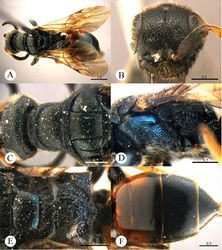Cleptes shengi
| Notice: | This page is derived from the original publication listed below, whose author(s) should always be credited. Further contributors may edit and improve the content of this page and, consequently, need to be credited as well (see page history). Any assessment of factual correctness requires a careful review of the original article as well as of subsequent contributions.
If you are uncertain whether your planned contribution is correct or not, we suggest that you use the associated discussion page instead of editing the page directly. This page should be cited as follows (rationale):
Citation formats to copy and paste
BibTeX: @article{Wei2013ZooKeys362, RIS/ Endnote: TY - JOUR Wikipedia/ Citizendium: <ref name="Wei2013ZooKeys362">{{Citation See also the citation download page at the journal. |
Ordo: Hymenoptera
Familia: Chrysididae
Genus: Cleptes
Name
Cleptes shengi Wei & Rosa & Xu, 2013 sp. n. – Wikispecies link – ZooBank link – Pensoft Profile
- Cleptes semiauratus: Sheng et al. 1998[1]: 7 (misidentification).
Material examined
Holotype ♀ (SCAU), Jilin, Maoershan National Forest Park (42°51'23.72"N, 129°28'12.36"E), 15.VI.2010, Mao-ling Sheng leg., No. SCAU-C0035.
Diagnosis
Cleptes shengi sp. n. is related to Cleptes semiauratus (Linnaeus), based on the similar sculptures on pronotum and mesopleuron. However, it can be separated by the evident differences in colouration: head and mesosoma mostly black, mesopleuron with metallic blue (head and pronotum flame red, mesonotum and metanotum golden red or golden green in Cleptes semiauratus).
Description
Female. Holotype.Body length 6.7 mm (Plate 10A). Forewing length 4.6 mm. HW: HH: HL = 15: 14: 8. POL: OOL: OCL = 4.8: 6: 8.8. MS = 1.4 MOD. Width of clypeal lower margin = 1.2 ASD. L/W of Ped, F-I, F-II, and F-III are 1.9, 2.0, 1.0, and 0.8, respectively.
Head. Head with dense punctures (1 PD), and slightly denser and coarser on vertex. Frontal sulcus incomplete, interrupted medially (Plate 10B). Clypeus with lower margin truncate, with indistinct acute teeth at corners. Mandible with three teeth. Ocellar triangle isosceles, without post-ocellar sulcus.
Mesosoma. Pronotum with similar punctures to those on vertex. Pronotum with a distinct anterior and posterior pit rows (Plate 10C); without longitudinal median sulcus (Plate 10C). Mesonotum with shallow and sparse punctures. Mesoscutum with notauli complete; parapsidal lines incomplete, 3/4 length of notauli; admedian lines absent; axillary trough with tubercle-like process (Plate 10C). Mesopleuron transversely striate, with short scrobal sulcus (Plate 10D). A foveate transverse sulcus present between mesoscutellum and metanotum (Plate 10E). Metanotum with a big and oval anteromedian pit, with two foveae along the posterior margin (Plate 10E). Metapleuron obliquely and strongly striate (Plate 10D). Dorsal surface of propodeum irregularly reticulate. Propodeal angles short and blunt (Plate 10E).
Metasoma. T-I and T-IV with sparse punctures. T-II and T-III with dense punctures (Plate 10F).
Pubescence. Face and vertex with short (0.8–1.0 MOD) and black hairs. Clypeus and mandibles with long (1.5–2.0 MOD), sparse and testaceous bristles. Metasoma on T-I and T-II laterally with very short (0.5 MOD), sparse and whitish hairs; on T-III and T-IV laterally, and on T-IV dorsally with long (1.0–1.3 MOD) hairs.
Colouration. Head, mandibles, scapes, mesosoma, tegulae, coxae, and femora black, with mesopleuron metallic blue. Antennae black, with pedicels, F-I, partly F-II testaceous. Legs black, with tibiae and tarsi testaceous. Metasoma black, with testaceous on T-I anteriorly and laterally and T-II laterally.
Male. Unknown.
Distribution
Palaearctic part of China (Jilin).
Biology
Parasitoids ofPachynematus itoi Okutani (Sheng et al. 1998[1]). Collected in June.
Etymology
The species is named after the collector.
Remarks
According to Móczár (2001)[2], Cleptes shengi sp. n. belongs to the semiauratus species-group based on the pronotum without longitudinal median sulcus and with both anterior and posterior pit rows distinct, and the colouration of metasoma.
Original Description
- Wei, N; Rosa, P; Xu, Z; 2013: Revision of the Chinese Cleptes (Hymenoptera, Chrysididae) with description of new species ZooKeys, 362: 55-96. doi
Other References
- ↑ 1.0 1.1 Sheng M, Gao L, Wang Q (1998) Studies on the parasitoids of Pachynematus itoi: I. Cleptes semiauratus and Endasys liaoningensis. Forest Pest and Disease 2: 7-8.
- ↑ Móczár L (2001) World revision of the Cleptessemiauratus group (Hymenoptera, Chrysididae, Cleptinae). Linzer Biologische Beiträge 33(1): 905-931.
Images
|
